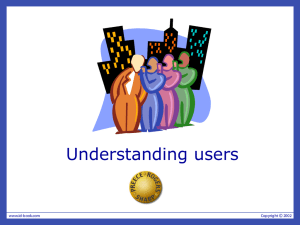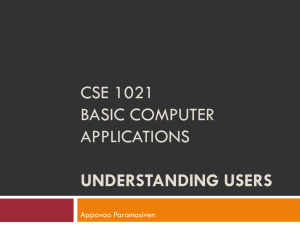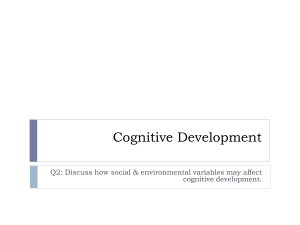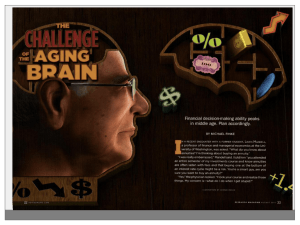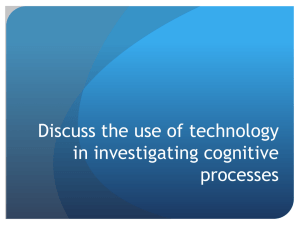Mental Representations and Cognitive Modeling
advertisement
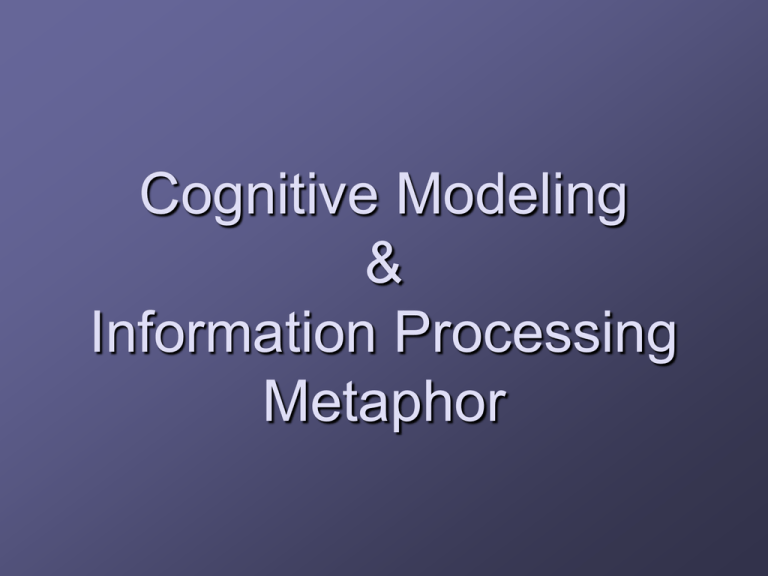
Cognitive Modeling & Information Processing Metaphor Cognitive Processes Learning and Memory Thinking and Reasoning (Planning, Decision Making, Problem Solving ...) Analogy and metaphor Language Vision-Perception Social Cognition Emotions Dreaming and Consciousness The Information-Processing Metaphor Mind has mental representations analogous to computer data structures, and computational procedures similar to computational algorithms. Symbolic View: mind contains such mental representations as logical propositions, rules, concepts, images, and analogies, and that it uses mental procedures such as deduction, search, matching, rotating, and retrieval. Connectionist View: mental representations use neurons and their connections as mechanisms for data structures, and neuron firing and spreading activation as the algorithms – i.e., cognition can be explained by using artificial neural networks Cognitive Modeling A model is a simplified (usually formal) representation of reality Cognitive modeling Create formal (e.g. mathematical, algorithmic, symbolic) representations of cognitive processes Then, use these models to predict or explain behavior associated with those cognitive processes Computational modeling: the models usually implemented as computer programs with output corresponding to the predicted behavior Example of cognitive process: categorizing objects into groups. Modeling: use decision trees, or neural networks, or rules, etc. The Function of Computational Models Computational Cognitive Model Simulates Generates Cognitive Process Implements Behaviour Explains Describes Theory Strategies Develop a model of some task or behaviour in order to learn more about it. Implement a pre-existing, verbally specified highly complex theory to see if its theoretical assumptions are sufficient/necessary to account for the target behaviour. Generate predictions/hypotheses to be then tested by behavioural experiments. Cognitive models of individual processes vs “unified” approach – cognitive architectures Practical Uses of Cognitive Modeling Clinical psychology: use cognitive models to assess differences in cognitive processing between normal individuals and clinical patients (e.g., schizophrenics). Cognitive neuroscience use cognitive models to understand the psychological function of different brain regions. Human factors use cognitive models to improve human-computer interactions and user interfaces Artificial intelligence and robotics use cognitive models for automated detection of dangerous targets automated recognition of speech or handwriting, or faces approach and avoidance movement behavior of robots. Economics and sociology use cognitive models to construct computerized agents in agent based models of market behavior or social network working. Cognitive Architectures Cognitive architectures are blueprints for intelligent agents. Unified frameworks for cognitive modeling which attempt to model all cognitive processes as well as the structural properties of the modeled system Famous Cognitive Architectures ACT-R, developed at Carnegie Mellon University under John R. Anderson. Soar, developed under Allen Newell and John Laird at Carnegie Mellon University and the University of Michigan. EPIC, developed under David E. Kieras and David E. Meyer at the University of Michigan Apex developed under Michael Freed at NASA Ames Research Center. Psi developed under Dietrich Dörner at the OttoFriedrich University in Bamberg, Germany. Marr’s Tri-Level Hypothesis Revisited Three kinds of questions All cognitive scientists agree that cognition involves information processing To explain an information processor, three different vocabularies have to be used – each requiring knowledge from different disciplines "Trying to understand vision by studying only neurons is like trying to understand bird flight by studying only feathers: it just cannot be done." Levels of Analysis: Background [ -- Continuing Marr (1982)]: “This duality – the representation and the processing of information – lies at the heart of most information-processing tasks and will profoundly shape Our investigation of the particular problems posed by vision.” - If one accepts the information-processing approach, how does one move forward in understanding a complex information-processing system (e.g. some aspect of cognition, such as vision)? ~ Marr’s suggestion – Three Levels of Understanding Three Levels (from Marr, 1982): Levels of analysis (Marr): Three kinds of questions must be answered computation what is the problem? inputs, outputs what is being computed or maximized? algorithm what are the methods? Data representation, “process” implementation what are the physical mechanisms? springs or neurons An Example: Calculator Imagine a calculator that is being used to do some basic arithmetic. How would you explain to someone how the calculator works? Implementation Level One approach would be to explain the physical operations of the calculator, by appealing to the properties of its transistors, resistors, capacitors, and so on. What would this explanation miss? Algorithmic Level Another approach would be to explain the information processing steps (the program) carried out by the calculator What would this explanation miss? Computational Level Yet another approach would be to specify the laws of arithmetic, and prove that the behavior of the calculator conforms to these abstract laws What would this explanation miss? A+B=B+A A+ 0=A A+(B+C) = (A+B)+C AxB=BxA Ax0=0 Ax1=A A x(B+C) = (AxB)+(AxC) …. The Tri-Level Hypothesis Symbolic View of the Algorithm and Representation Level An information processor uses symbols to represent the world Rules are used to manipulate these symbols or tokens When rules are applied, the symbol manipulations preserve meaning One solves problems, or finds new meanings, by manipulating symbols according to the “rules of the game” Types of Representations Formal Logic: assumes mental representations similar to sentences in predicate logic. deductive and inductive procedures, applied to the sentences, produce the inferences. Rules (IF … THEN ): many cognitive processes such as planning can be modeled by rule-based systems assumes mental representations as rules and procedures for using these rules to search a space of possible solutions, and procedures for generating new rules. Types of Representations Concepts: mental representations are concepts (related to words) and relationships among the concepts often represented as a set of features mental procedures including spreading activation, matching, and inheritance used to produce behavior Analogies: computational models simulate how people retrieve and map source analogs in order to apply them to target situations. assumes people have verbal and visual representations of situations that can be used as cases or analogs, as well as processes of retrieval, mapping, and adaptation that operate on those analogs. the analogical processes, applied to the representations of analogs, produce the behavior. Types of Representations Images: pictorial representations capture visual and spatial information in a much more usable form than lengthy verbal descriptions. so, people have visual images of situations, and processes such as scanning and rotation that operate on those images. the processes for constructing and manipulating images produce the intelligent behavior some metaphorical aspects of language may have their roots in imagery. Connectionist Networks (neural nets): people have representations that involve simple processing units linked to each other by excitatory and inhibitory connections. processes that spread activation between the units via their connections, as well as processes for modifying the connections and learning. Exercise Consider the addition example given earlier Write a more general algorithm for adding any two 2-digit numbers (you can use symbols to represent digits and IF-Then rules to model conditions. Exercise 2 Can you solve the following problem? Exercise 2 (cont.) How do you solve the previous problem after reading the following story?

